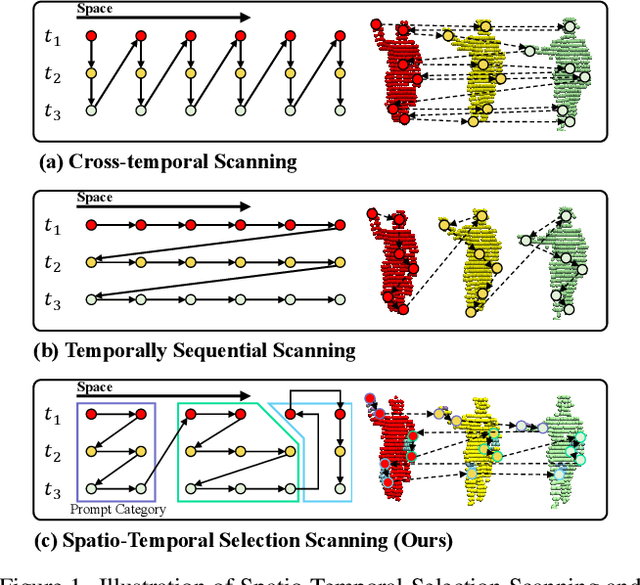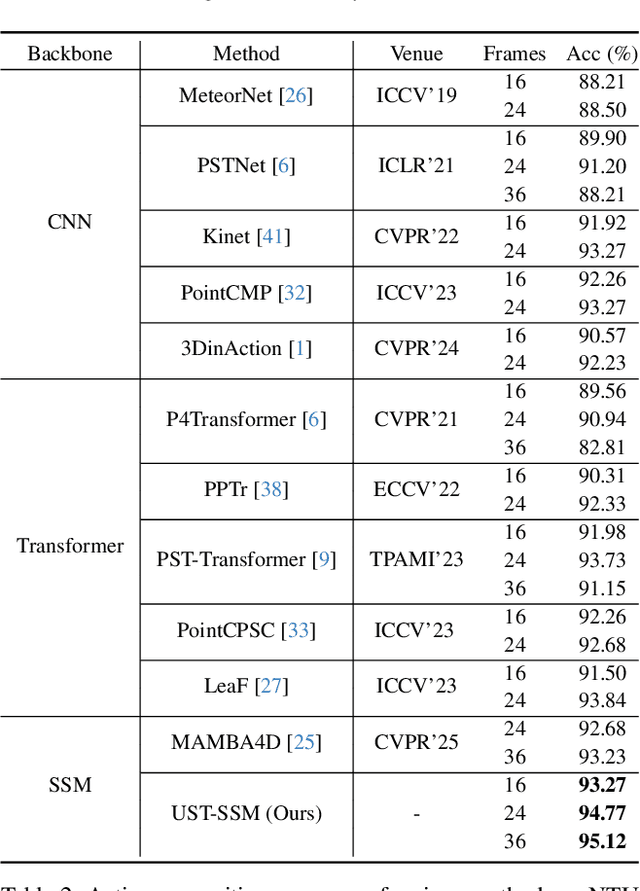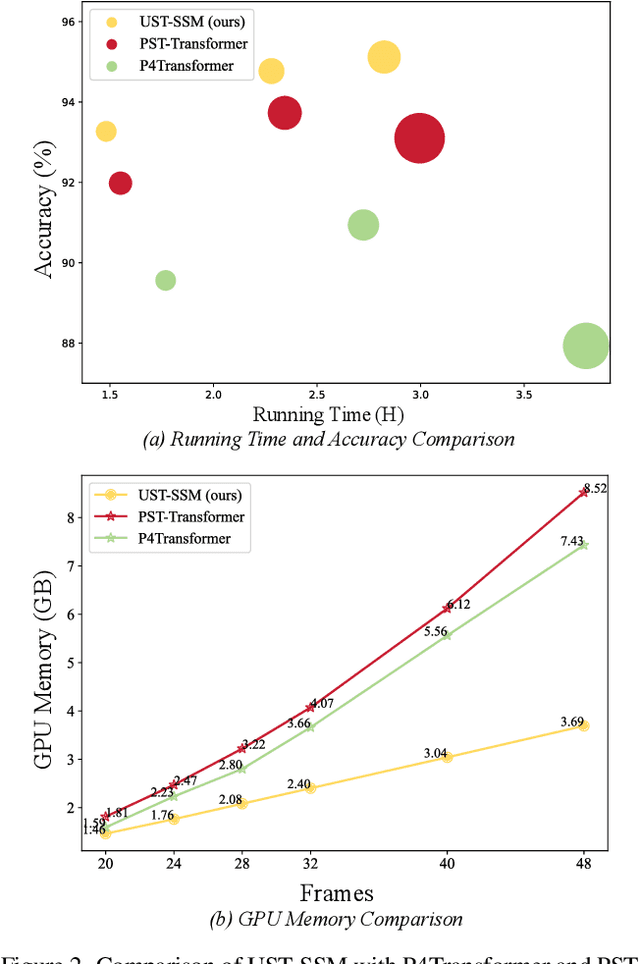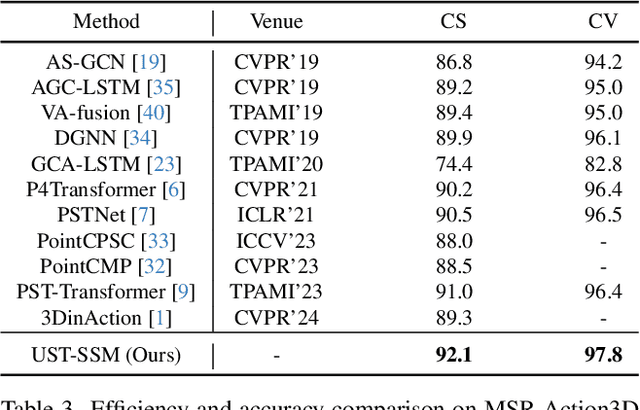Junsong Yuan
UST-SSM: Unified Spatio-Temporal State Space Models for Point Cloud Video Modeling
Aug 20, 2025



Abstract:Point cloud videos capture dynamic 3D motion while reducing the effects of lighting and viewpoint variations, making them highly effective for recognizing subtle and continuous human actions. Although Selective State Space Models (SSMs) have shown good performance in sequence modeling with linear complexity, the spatio-temporal disorder of point cloud videos hinders their unidirectional modeling when directly unfolding the point cloud video into a 1D sequence through temporally sequential scanning. To address this challenge, we propose the Unified Spatio-Temporal State Space Model (UST-SSM), which extends the latest advancements in SSMs to point cloud videos. Specifically, we introduce Spatial-Temporal Selection Scanning (STSS), which reorganizes unordered points into semantic-aware sequences through prompt-guided clustering, thereby enabling the effective utilization of points that are spatially and temporally distant yet similar within the sequence. For missing 4D geometric and motion details, Spatio-Temporal Structure Aggregation (STSA) aggregates spatio-temporal features and compensates. To improve temporal interaction within the sampled sequence, Temporal Interaction Sampling (TIS) enhances fine-grained temporal dependencies through non-anchor frame utilization and expanded receptive fields. Experimental results on the MSR-Action3D, NTU RGB+D, and Synthia 4D datasets validate the effectiveness of our method. Our code is available at https://github.com/wangzy01/UST-SSM.
PP-Motion: Physical-Perceptual Fidelity Evaluation for Human Motion Generation
Aug 11, 2025Abstract:Human motion generation has found widespread applications in AR/VR, film, sports, and medical rehabilitation, offering a cost-effective alternative to traditional motion capture systems. However, evaluating the fidelity of such generated motions is a crucial, multifaceted task. Although previous approaches have attempted at motion fidelity evaluation using human perception or physical constraints, there remains an inherent gap between human-perceived fidelity and physical feasibility. Moreover, the subjective and coarse binary labeling of human perception further undermines the development of a robust data-driven metric. We address these issues by introducing a physical labeling method. This method evaluates motion fidelity by calculating the minimum modifications needed for a motion to align with physical laws. With this approach, we are able to produce fine-grained, continuous physical alignment annotations that serve as objective ground truth. With these annotations, we propose PP-Motion, a novel data-driven metric to evaluate both physical and perceptual fidelity of human motion. To effectively capture underlying physical priors, we employ Pearson's correlation loss for the training of our metric. Additionally, by incorporating a human-based perceptual fidelity loss, our metric can capture fidelity that simultaneously considers both human perception and physical alignment. Experimental results demonstrate that our metric, PP-Motion, not only aligns with physical laws but also aligns better with human perception of motion fidelity than previous work.
Recognizing Actions from Robotic View for Natural Human-Robot Interaction
Jul 30, 2025



Abstract:Natural Human-Robot Interaction (N-HRI) requires robots to recognize human actions at varying distances and states, regardless of whether the robot itself is in motion or stationary. This setup is more flexible and practical than conventional human action recognition tasks. However, existing benchmarks designed for traditional action recognition fail to address the unique complexities in N-HRI due to limited data, modalities, task categories, and diversity of subjects and environments. To address these challenges, we introduce ACTIVE (Action from Robotic View), a large-scale dataset tailored specifically for perception-centric robotic views prevalent in mobile service robots. ACTIVE comprises 30 composite action categories, 80 participants, and 46,868 annotated video instances, covering both RGB and point cloud modalities. Participants performed various human actions in diverse environments at distances ranging from 3m to 50m, while the camera platform was also mobile, simulating real-world scenarios of robot perception with varying camera heights due to uneven ground. This comprehensive and challenging benchmark aims to advance action and attribute recognition research in N-HRI. Furthermore, we propose ACTIVE-PC, a method that accurately perceives human actions at long distances using Multilevel Neighborhood Sampling, Layered Recognizers, Elastic Ellipse Query, and precise decoupling of kinematic interference from human actions. Experimental results demonstrate the effectiveness of ACTIVE-PC. Our code is available at: https://github.com/wangzy01/ACTIVE-Action-from-Robotic-View.
$A^2R^2$: Advancing Img2LaTeX Conversion via Visual Reasoning with Attention-Guided Refinement
Jul 28, 2025Abstract:Img2LaTeX is a practically significant task that involves converting mathematical expressions or tabular data from images into LaTeX code. In recent years, vision-language models (VLMs) have demonstrated strong performance across a variety of visual understanding tasks, owing to their generalization capabilities. While some studies have explored the use of VLMs for the Img2LaTeX task, their performance often falls short of expectations. Empirically, VLMs sometimes struggle with fine-grained visual elements, leading to inaccurate LaTeX predictions. To address this challenge, we propose $A^2R^2$: Advancing Img2LaTeX Conversion via Visual Reasoning with Attention-Guided Refinement, a framework that effectively integrates attention localization and iterative refinement within a visual reasoning framework, enabling VLMs to perform self-correction and progressively improve prediction quality. For effective evaluation, we introduce a new dataset, Img2LaTex-Hard-1K, consisting of 1,100 carefully curated and challenging examples designed to rigorously evaluate the capabilities of VLMs within this task domain. Extensive experimental results demonstrate that: (1) $A^2R^2$ significantly improves model performance across six evaluation metrics spanning both textual and visual levels, consistently outperforming other baseline methods; (2) Increasing the number of inference rounds yields notable performance gains, underscoring the potential of $A^2R^2$ in test-time scaling scenarios; (3) Ablation studies and human evaluations validate the practical effectiveness of our approach, as well as the strong synergy among its core components during inference.
Anomaly Detection and Generation with Diffusion Models: A Survey
Jun 11, 2025



Abstract:Anomaly detection (AD) plays a pivotal role across diverse domains, including cybersecurity, finance, healthcare, and industrial manufacturing, by identifying unexpected patterns that deviate from established norms in real-world data. Recent advancements in deep learning, specifically diffusion models (DMs), have sparked significant interest due to their ability to learn complex data distributions and generate high-fidelity samples, offering a robust framework for unsupervised AD. In this survey, we comprehensively review anomaly detection and generation with diffusion models (ADGDM), presenting a tutorial-style analysis of the theoretical foundations and practical implementations and spanning images, videos, time series, tabular, and multimodal data. Crucially, unlike existing surveys that often treat anomaly detection and generation as separate problems, we highlight their inherent synergistic relationship. We reveal how DMs enable a reinforcing cycle where generation techniques directly address the fundamental challenge of anomaly data scarcity, while detection methods provide critical feedback to improve generation fidelity and relevance, advancing both capabilities beyond their individual potential. A detailed taxonomy categorizes ADGDM methods based on anomaly scoring mechanisms, conditioning strategies, and architectural designs, analyzing their strengths and limitations. We final discuss key challenges including scalability and computational efficiency, and outline promising future directions such as efficient architectures, conditioning strategies, and integration with foundation models (e.g., visual-language models and large language models). By synthesizing recent advances and outlining open research questions, this survey aims to guide researchers and practitioners in leveraging DMs for innovative AD solutions across diverse applications.
Texture or Semantics? Vision-Language Models Get Lost in Font Recognition
Mar 31, 2025Abstract:Modern Vision-Language Models (VLMs) exhibit remarkable visual and linguistic capabilities, achieving impressive performance in various tasks such as image recognition and object localization. However, their effectiveness in fine-grained tasks remains an open question. In everyday scenarios, individuals encountering design materials, such as magazines, typography tutorials, research papers, or branding content, may wish to identify aesthetically pleasing fonts used in the text. Given their multimodal capabilities and free accessibility, many VLMs are often considered potential tools for font recognition. This raises a fundamental question: Do VLMs truly possess the capability to recognize fonts? To investigate this, we introduce the Font Recognition Benchmark (FRB), a compact and well-structured dataset comprising 15 commonly used fonts. FRB includes two versions: (i) an easy version, where 10 sentences are rendered in different fonts, and (ii) a hard version, where each text sample consists of the names of the 15 fonts themselves, introducing a stroop effect that challenges model perception. Through extensive evaluation of various VLMs on font recognition tasks, we arrive at the following key findings: (i) Current VLMs exhibit limited font recognition capabilities, with many state-of-the-art models failing to achieve satisfactory performance. (ii) Few-shot learning and Chain-of-Thought (CoT) prompting provide minimal benefits in improving font recognition accuracy across different VLMs. (iii) Attention analysis sheds light on the inherent limitations of VLMs in capturing semantic features.
dFLMoE: Decentralized Federated Learning via Mixture of Experts for Medical Data Analysis
Mar 13, 2025Abstract:Federated learning has wide applications in the medical field. It enables knowledge sharing among different healthcare institutes while protecting patients' privacy. However, existing federated learning systems are typically centralized, requiring clients to upload client-specific knowledge to a central server for aggregation. This centralized approach would integrate the knowledge from each client into a centralized server, and the knowledge would be already undermined during the centralized integration before it reaches back to each client. Besides, the centralized approach also creates a dependency on the central server, which may affect training stability if the server malfunctions or connections are unstable. To address these issues, we propose a decentralized federated learning framework named dFLMoE. In our framework, clients directly exchange lightweight head models with each other. After exchanging, each client treats both local and received head models as individual experts, and utilizes a client-specific Mixture of Experts (MoE) approach to make collective decisions. This design not only reduces the knowledge damage with client-specific aggregations but also removes the dependency on the central server to enhance the robustness of the framework. We validate our framework on multiple medical tasks, demonstrating that our method evidently outperforms state-of-the-art approaches under both model homogeneity and heterogeneity settings.
Aligning Instance-Semantic Sparse Representation towards Unsupervised Object Segmentation and Shape Abstraction with Repeatable Primitives
Mar 10, 2025Abstract:Understanding 3D object shapes necessitates shape representation by object parts abstracted from results of instance and semantic segmentation. Promising shape representations enable computers to interpret a shape with meaningful parts and identify their repeatability. However, supervised shape representations depend on costly annotation efforts, while current unsupervised methods work under strong semantic priors and involve multi-stage training, thereby limiting their generalization and deployment in shape reasoning and understanding. Driven by the tendency of high-dimensional semantically similar features to lie in or near low-dimensional subspaces, we introduce a one-stage, fully unsupervised framework towards semantic-aware shape representation. This framework produces joint instance segmentation, semantic segmentation, and shape abstraction through sparse representation and feature alignment of object parts in a high-dimensional space. For sparse representation, we devise a sparse latent membership pursuit method that models each object part feature as a sparse convex combination of point features at either the semantic or instance level, promoting part features in the same subspace to exhibit similar semantics. For feature alignment, we customize an attention-based strategy in the feature space to align instance- and semantic-level object part features and reconstruct the input shape using both of them, ensuring geometric reusability and semantic consistency of object parts. To firm up semantic disambiguation, we construct cascade unfrozen learning on geometric parameters of object parts.
Lost in Edits? A $λ$-Compass for AIGC Provenance
Feb 05, 2025



Abstract:Recent advancements in diffusion models have driven the growth of text-guided image editing tools, enabling precise and iterative modifications of synthesized content. However, as these tools become increasingly accessible, they also introduce significant risks of misuse, emphasizing the critical need for robust attribution methods to ensure content authenticity and traceability. Despite the creative potential of such tools, they pose significant challenges for attribution, particularly in adversarial settings where edits can be layered to obscure an image's origins. We propose LambdaTracer, a novel latent-space attribution method that robustly identifies and differentiates authentic outputs from manipulated ones without requiring any modifications to generative or editing pipelines. By adaptively calibrating reconstruction losses, LambdaTracer remains effective across diverse iterative editing processes, whether automated through text-guided editing tools such as InstructPix2Pix and ControlNet or performed manually with editing software such as Adobe Photoshop. Extensive experiments reveal that our method consistently outperforms baseline approaches in distinguishing maliciously edited images, providing a practical solution to safeguard ownership, creativity, and credibility in the open, fast-evolving AI ecosystems.
SLCGC: A lightweight Self-supervised Low-pass Contrastive Graph Clustering Network for Hyperspectral Images
Feb 05, 2025Abstract:Self-supervised hyperspectral image (HSI) clustering remains a fundamental yet challenging task due to the absence of labeled data and the inherent complexity of spatial-spectral interactions. While recent advancements have explored innovative approaches, existing methods face critical limitations in clustering accuracy, feature discriminability, computational efficiency, and robustness to noise, hindering their practical deployment. In this paper, a self-supervised efficient low-pass contrastive graph clustering (SLCGC) is introduced for HSIs. Our approach begins with homogeneous region generation, which aggregates pixels into spectrally consistent regions to preserve local spatial-spectral coherence while drastically reducing graph complexity. We then construct a structural graph using an adjacency matrix A and introduce a low-pass graph denoising mechanism to suppress high-frequency noise in the graph topology, ensuring stable feature propagation. A dual-branch graph contrastive learning module is developed, where Gaussian noise perturbations generate augmented views through two multilayer perceptrons (MLPs), and a cross-view contrastive loss enforces structural consistency between views to learn noise-invariant representations. Finally, latent embeddings optimized by this process are clustered via K-means. Extensive experiments and repeated comparative analysis have verified that our SLCGC contains high clustering accuracy, low computational complexity, and strong robustness. The code source will be available at https://github.com/DY-HYX.
 Add to Chrome
Add to Chrome Add to Firefox
Add to Firefox Add to Edge
Add to Edge